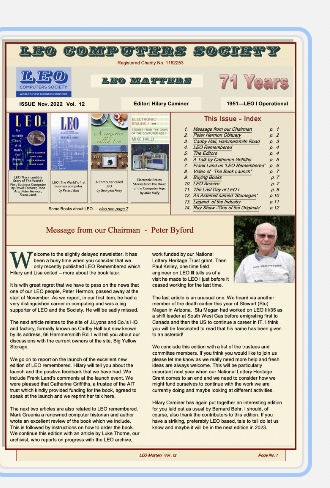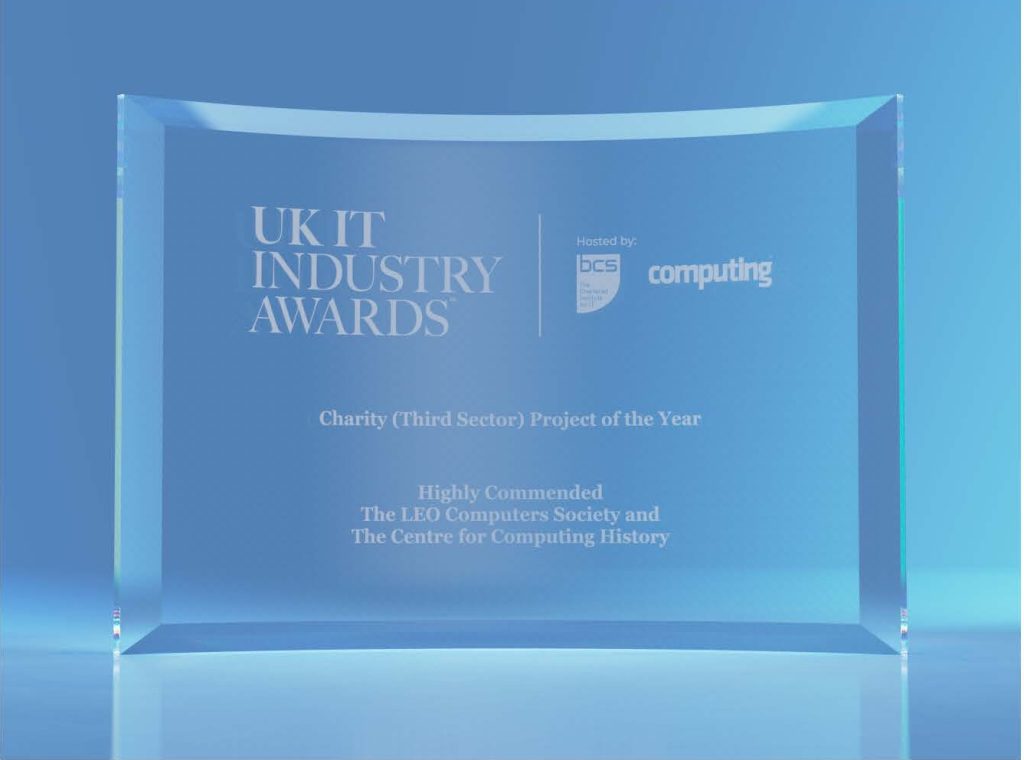Guidelines for Writing Memoirs, Reminiscences and Anedotes Read More »
LEO Matters Issue 16, November 2024 has been published and circulated to Members and others. It can be downloaded by following the download link on this page .
LEO Matters issue 16, November 2024 Read More »
Books
We have three books about LEO available for you to buy directly from us – all proceeds go towards supporting the Society’s ongoing work. Once you request a book we will work out the postage costs for you based on delivery address.
1. Peter Bird’s hardback ‘LEO, The first Business Computer’ was published in 1994 and gives a very thorough history of the origins and development of LEO. £10. I would like to discount this down to £5 as copies are now showing signs of their age!
2. Georgina Ferry’s paperback ‘A computer called LEO’, first published 2003, is a less technical account of the history of LEO set in its social context. £8.
3. ‘LEO Remembered – by the people who worked on the world’s first business computer.’ This is an anthology of over 80 reminiscences by LEO people illustrated with contemporary photographs. We launched our new edition in September 2022 and are delighted that it received excellent reviews. £8.
Books about LEO available for Sale Read More »
We are delighted to be able to announce that we have appointed Kate Stockwell to this new position. Kate impressed the selection panel of Lisa McGerty, Peter Byford and Hilary Caminer and is scheduled to take up her post on Wednesday, 12th March.
Kate will be working on the LEO archive at CCH – following on the excellent work carried out as part of the NLHF project by Jude Brimmer and Luke Thorne. This new post has been generously funded by the AIT Trust and is named in honour of Frank and Ralph Land, key figures in the development and marketing of LEO from its earliest days. Kate will be working three days a week, Wednesday to Friday for two years.
Kate shows enormous enthusiasm for archiving work, and has recent highly-praised experience in projects at several Cambridge colleges on a variety of themes. We will ask her to introduce herself to you all in the near future.
In the meantime, we feel it is great news that work on the LEO archive can now resume.
Kate Stockwell appointed as Land Archivist Read More »
LEO Matters Issue 15, November 2024 has been published and circulated to Members and others. It can be downloaded by following the download link on this page .
LEO Matters issue 15, June 2024 Read More »
Test links
leo-computers.org.uk/Videos
Andrew Herbert, is a distinguished Computer Science practitioner who hails from the Cambridge Tradition. Having held a very senior position in Microsoft Research, in retirement he is the leader of the project on display at TNMoC to construct a replica of the pioneering EDSAC I computer at the University of Cambridge which first went into service in 1949.
On 26 April 2024 Andre spoke to the LEO Computer Society on Zoom about the reconstruction project , now close to completion. He spoke of the challenges of reconstructing a machine for which there were very few surviving circuit diagrams – the EDSAC reconstruction team worked mostly from contemporary photographs and secondary sources and research into established circuits for “computing with waveforms” known to 1940s electronics engineers.
A recording is available here Zoom Recording
Copy of the slides used can be found here Slides
Rebuild of EDSAC at TNMoC: Presented by Andrew Herbert Read More »
Over time there have been a number of programmes on the BBC Radio which have talked about LEO. Neville Lyons put together material extracted from the BBC programmes together with relevant Slides to provide visual content and this was presented on 12 December 2023. A recording is available here Zoom Recording
To listen to the original BBC material without the slides you can follow the links below.
LEO the Electronic Office from BBC Radio 4 Computing Britain
December 23
Since 2018 the Cambridge-based Centre for Computing History (CCH) has been working in partnership with the LEO Computers Society on a lottery-funded project to provide a long-term, centralised home for the society’s historically important and internationally significant heritage relating to LEO (Lyons Electronic Office), the world’s first business computer, so that the collection is accessible to the public.
The lottery project ended formally in June this year, but the cooperation of the two organisations continues. The result to date is that the Cambridge centre now looks after many thousands of individual items – as well as their newly created digital equivalents – and the partners continue to promote the LEO story in various ways. Their most innovative approach is an award-winning digital ‘rebuild’ of the original LEO, available both in a display at CCH and, in a major step forward in opening up access from anywhere in the world, via tablet devices.
The virtual LEO is an historically accurate digital representation of the first LEO machine. Unlike a physical rebuild, it also points to the social context of post-war London and the Lyons company context within which LEO I was constructed.
And because the staff of J Lyons & Company and LEO Computers Limited were meticulous record keepers, recording not just decisions at every step of the journey, but the reasons for those decisions and their consequences, the museum has been able to cast the collection in a wider social context, bringing the human and social stories involved to the fore.
The virtual LEO app is already picking up industry awards, most recently last month when it achieved a ‘highly commended’ in the charities category of the British Computer Society’s UK IT awards, a glitzy affair held annually to reward achievements across the IT industry.
For further details on what the app is and how to download it, visit the LEO I website https://www.leo1.co.uk/
Virtual LEO I
In May this year, a PC-based version of the virtual LEO was installed at the Centre for Computing History and Dr Lisa McGerty, Chief Executive of the museum and the project’s lead commented, “Watching visitors of all kinds use it since then has been a real joy for me. And now, the virtual LEO has also been made available for access from the ubiquitous Apple iPad and the new app is going down a storm.”
Using either version of the virtual LEO, it is possible to ‘wander around’ the LEO room in Cadby Hall, the former Lyons’ HQ complex in Hammersmith, and view the racks of valves, hear all the peripherals and even look out of the window at the 1950s smog. Within the app, there are 35 interactive objects that can be ‘picked up’ and explored, and there are 44 documents, six film snippets and many photos from the archive, accompanied by over 40,000 words of explanatory text divided into six themes. It has been purposely designed in layers so that it is perfectly possible just to walk around the room and see and hear what it was like to operate the first LEO, or one can dig deeper into the wider story.
An Android version of the app is also currently in development and is planned for release shortly.
In a further comment, Hilary Caminer, the LEO Society’s secretary expressed her own amazement in saying: “I think it is a remarkable feat to put that enormous, epoch-making and room-sized early mainframe on to a palm-sized tablet. What would those early pioneers have thought and said?”
Other highlights of the collection
Over the course of the project, there were more than 50 separate deposits of LEO material made to the Cambridge museum by LEO Society members, some consisting of a single document or photograph, but the majority were of multiple documents – in some cases boxes of them – and there were some objects too, such as small pieces of various LEO machines including tape reels and logic boards.
These have been catalogued, digitised and in some cases transcribed, making more than 1,600 separate items available online to all, via the CCH website. These incorporate almost 13,000 scanned pages of documentation in total. On the CCH website these sit alongside the CCH version of the LEO Society’s Leopedia database, extending that resource in a wholly searchable and search engine optimised way. Whereas Leopedia lists references to secondary sources of information on LEO in books, journals and in the media, the archive catalogue lists and makes available the primary material.
The digitised LEO collection and the CCH version of Leopedia can be found athttps://www.computinghistory.org.uk/pages/52267/LEOPEDIA/..
Finding aids are also available and are being extended all the time so that the collection can be searched easily by people who know nothing about LEO – for example by subject – see https://www.computinghistory.org.uk/det/55802/explore-our-leo-computers-collection/.
The archive includes reports from visits Lyons staff made to Cambridge at the very beginning of the Lyons-Cambridge University partnership during the development of EDSAC; photographs of the construction of LEO I, particularly those that point to the experimental nature of the early machine; a memo from TR Thompson reporting on the first fully successful and complete run of the world’s first commercial computer job, Lyons Bakery Valuations, which was completed at 2:35pm on 30th November 1951; extremely rare BBC film footage of LEO I running the Lyons payroll as well as other snippets of film; over 60 oral history interviews and more than 200 written reminiscences collected during the project and over the years. And much more besides.
LEO Documentary Film
The lottery project funding also allowed for the creation of a short documentary of the LEO story. Produced by Boffin Media, the film won the Association for British Science Writers (ABSW) Video of the Year Award in July 2022.
The film is available on YouTube and can be found via the museum’s website (https://www.computinghistory.org.uk/det/66720/66720-LEO-The-story-of-the-world-s-first-business-computer/). It was produced to coincide with the 70th anniversary of LEO I’s first fully successful live program run in November 2021.
-ends –
A VIRTUAL EXPERIENCE OF THE WORLD’S FIRST BUSINESS COMPUTER Read More »


